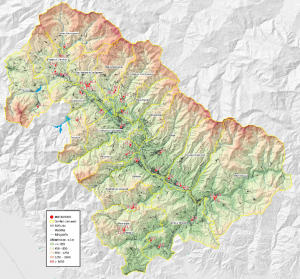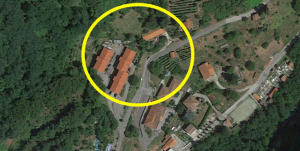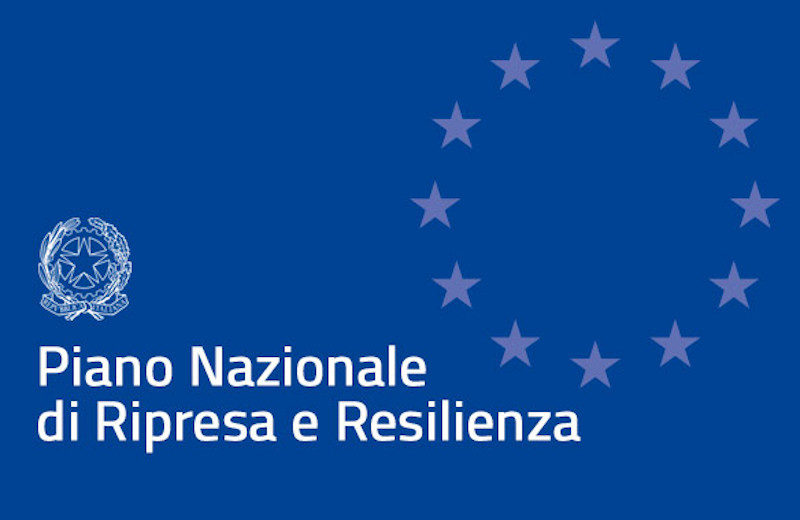

The PNational Recovery and Resilience Plan (NRP), is the document outlining the goals that, through reforms and investments, Italy intends to achieve through the use of European funds from the Next Generation EU (NGEU) program, the €750 billion package agreed by the European Union in response to the pandemic crisis, and envisages investments of 191.5 billion euros from the Recovery and Resilience Facility joined by an additional 30.6 billion from the Complementary Fund and 13 billion from the React EU Program, for the financial coverage of a National Investment Plan of those projects consistent with the strategies of the NGEU.
The Plan is developed around three strategic axes shared at the European level: digitization and innovation, ecological transition, and social inclusion (gender equality, the protection and empowerment of young people, and bridging territorial gaps) and is divided into six Missions that are in turn divided into 16 components.
NRP investment projects are divided into 16 components, grouped in turn into 6 Missions:
-
- Digitalization, innovation, competitiveness, culture and tourism
.
- Green Revolution and Ecological Transition
- Infrastructures for sustainable mobility
- Education and research
- Inclusion and cohesion
- Health
The municipality of Fabbriche di Vergemoli is implementing the following measures:.
# – Mission 1 – Digitalization, Innovation, Competitiveness, Culture and Tourism – Component 1 – Digitalization, Innovation and Security in PA:
- investment 1.2 – Enabling and facilitating migration to the Cloud;
- investment 1.3.1 – National Digital Data Platform;
- investment 1.4.1 – Citizen Experience in Public Services;
- investment 1.4.4 – Digital Identity Adoption;
# – Mission 1 – Digitization, Innovation, Competitiveness and Culture – Component 3 – Culture 4.0 (M1C3) – Measure 2 – “Regeneration of Small Cultural Sites, Cultural, Religious and Rural Heritage” – Investment 2.1: “Attractiveness of Historic Villages” – Line of Intervention B – Cultural and Social Regeneration of Historic Villages;
# – Mission 5 – Cohesion and Inclusion – Component 2 – Measure 2.3 – “National Innovative Program Quality of Living (PINQuA).”
# – Mission 5 – Cohesion and Inclusion – Component 3 – Investment 1 – Line of Intervention 1.1.1 – “Strengthening of community social services and infrastructure”;
PINQuA inhabiting the Serchio Valley

![]()
The National Innovative Program for Housing Quality (PINQuA) is an investment program under the National Plan for Recovery and Resilience (PNRR) and promoted by the Ministry of Infrastructure (MIT) to carry out social housing and urban regeneration interventions throughout Italy.
The Program, envisaged in the Budget Law 2020, aims to regenerate the socio-economic fabric and increase the accessibility, safety of places and re-functionalization of public spaces and properties, in order to contribute to the improvement of social cohesion and the quality of life of citizens.
The operational details of the measure were set out in Decree No. 395 of Sept. 16, 2020, published in the Official Gazette on Nov. 16, which regulated the Program, dictating the conditions for accessing the funds and kicking off the submission of applications by municipalities and regions to get funding for city “restyling” projects.
The “Inhabiting the Serchio Valley” Project stems from the collaboration of the Unione dei Comuni Garfagnana and the Unione dei Comuni Media Valle del Serchio to create an opportunity to revitalize a vast territory characterized by environmental and settlement affinities and united in aspirations for cultural growth and socioeconomic development.
The choice constitutes a challenge of integration and planning in order to contribute to the increase in the quality of living; a comprehensive program of intervention that promotes processes of regeneration of urban areas located in the territory, strategic to the redevelopment and re-functionalization of social housing and regeneration of urban and socioeconomic fabrics.
With a view to overcoming administrative boundaries and constraints of geographic areas, the project is intended for the entire Serchio Valley (19 municipalities with a total land area of 881.27 sq. km.).
The project considers existing residential character building, service spaces, public spaces and urban redevelopment as effective integrated co-housing systems.
The interventions will produce widespread benefits in the area: from an increase in social housing, to the possibility of having on-site health care for the elderly, as well as access to remote training and work tools for young people, and public spaces for socialization and support for socio-cultural initiatives for inclusion and socialization.

Criticisms and strengths of the Serchio Valley
Based on the analyses and assessments made in the Knowledge Framework, the following strengths and criticalities of the Serchio Valley area can be identified for the purpose of defining The Project.
.
– CRITICALITY<//div>
- Consistent territorial depopulation
- Aging population
- Pendularism
- Deterioration and abandonment of the existing building stock
- Shortage of residence services
- Level of quality of services present
- Shortage in the mobility infrastructure system
- Fragility of the territory
- Unitary and homogeneous planning tools
- Coherence with superordinate plans
- Size of centers and settlement cores
- Existing building heritage with historical, architectural, testimonial value
- Available built heritage, not occupation of new land (“zero balance”)
- Environmental quality
- Projects/programs in place
- Presence of social promotion and voluntary associations
- Low crime rate
- Cost of living
.
- social-economic fabric regeneration: through the implementation of (realization of social housing), Country Cohousing, urban regeneration of the built-up area;
- improvement of social cohesion: Cohousing of Country;
- cultural enrichment: Country Cohousing and recovery and enhancement of cultural, environmental, landscape and architectural testimonies;
- quality of artifacts, places and the lives of citizens: Country Cohousing;
- economic and environmental sustainability with the activation of public financial resources and involvement of private operators;
- absence of consumption of new land: “zero balance” no intervention involves land consumption.
The project aims to contribute to the recovery and revitalization of areas, combating and preventing phenomena of degradation and abandonment, with specific attention to structural redevelopment, as well as to the active involvement of local communities, starting from the resources that these contexts can still offer and in the perspective of realizing paths of integration and development. Local communities are therefore the priority recipients of the planned project actions.
The project is specifically divided into 39 interventions.
The project is articulated according to the thematic areas that characterize each intervention, seeking to determine the impact of each on territorial effects. The main thematisms into which the interventions have been classified are as follows.
- Cohousing,
- Village cohousing,
- Urban regeneration (Cultural, landscape and environmental heritage, Open spaces.
The interventions proposed by the administration of the Municipality of Fabbriche di Vergemoli are as follows: .
9.1 Implementation energy efficiency housing ERP
Address: Via Sezzo – Fabbriche di Vallico

Description of intervention
The project involves the construction of a small biomass power plant to serve the entire apartment complex. The structure of the power plant housing and biomass storage room will be made of local reinforced concrete so as to harmonize the environmental inclusion in the surrounding landscape.
9.2 Parking serving Fabbriche di Vallico
Address: Via delle Pianelle – Fabbriche di Vallico

Description of intervention
The project involves the construction of a goods exchange and unloading area to be located in Via delle Pianelle, immediately outside the town center.
The project originates from the need on the part of the Municipal Administration of Fabbriche di
Vergemoli to give the possibility to develop and improve the accessibility and usability of the historical part of the village and at the same time reduce the parking problem for Fabbriche di Vallico, as well as from the creation of the Natural Shopping Center for which it is necessary to build a new parking area, central to the built-up area of Fabbriche di Vallico.
9.3 Village Cohousing Fabbriche di Vallico
Address: Via Campaccio – Fabbriche di Vallico

Intervention Description.
The intervention consists of the creation of spaces dedicated to services to the population, especially students and workers, where they can work in smart-working or take classes through distance learning.
No works of a building nature are planned, in fact, the interventions concern the completion and equipping of spaces within the municipality’s structure. This project therefore includes works of a plant engineering nature, with the implementation of the data network, necessary wiring, and connections for workstations.
It also includes the purchase of all the necessary furniture and equipment for the planned activities.
